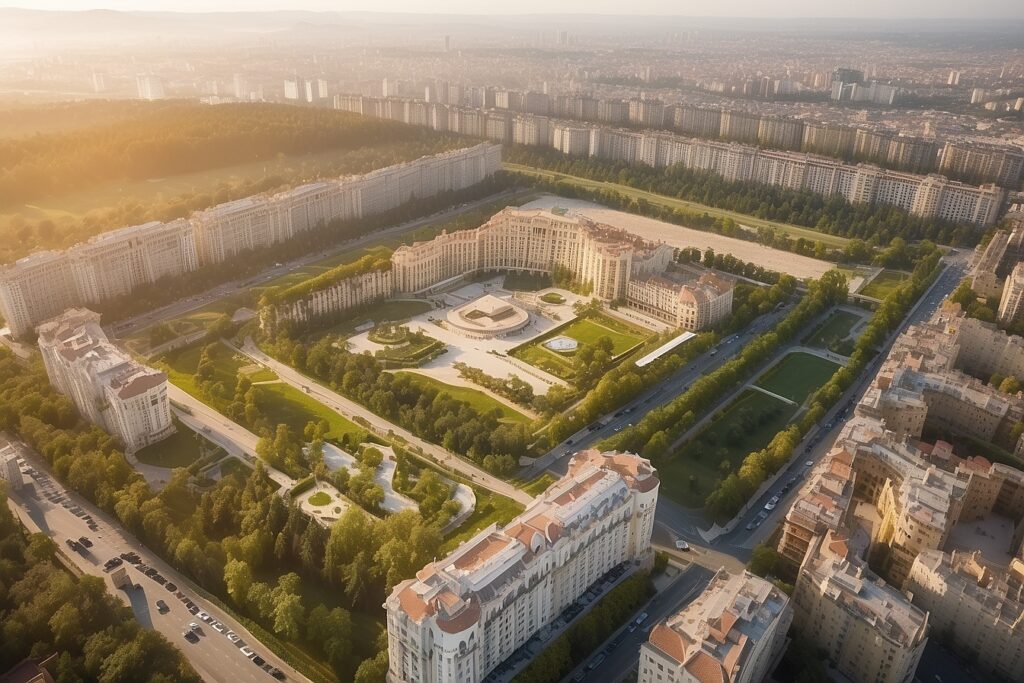Dive into the Dynamic Landscape of Bucharest’s Real Estate: From Economic Shifts to Pandemic Influences

Explore the multifaceted journey of Bucharest’s real estate market, intricately woven with the threads of Romania’s economic and political history. Witness the transformative impact of the country’s transition from a planned to a market-oriented economy in the 1990s and the subsequent boom and bust in the 2000s, triggered by the global financial crisis of 2008.
Delve into the pivotal role played by housing market policies, tax incentives, and subsidies in sculpting the contours of Bucharest’s real estate scenario. Uncover the recent paradigm shift induced by the COVID-19 pandemic, where homebuyers are increasingly drawn to properties featuring outdoor spaces and dedicated home offices.
Amidst these fluctuations, Bucharest remains a focal point for real estate investments. Discover the burgeoning interest in both suburban areas and the central districts of Sector 1 and Sector 2, as the city continues to evolve and thrive in the ever-changing real estate landscape.
Bucharest’s Residential Market: Affordable Housing Trends and Regional Dynamics
In the realm of Romania’s real estate, a surge in demand and increased affordability is anticipated, driven by the pressing need for residential units in dynamic cities and economic hubs grappling with overcrowding. Colliers’ experts predict a positive trajectory, fueled by robust wage growth and the impending relaxation of the central bank’s monetary policies by mid-2024.
Despite a recent dip in affordability, a turnaround is expected from 2023 onwards, presenting a promising landscape for prospective homebuyers. Deloitte’s Property Index for 2023 reaffirms Romania’s standing as one of Europe’s most affordable housing markets. With an average price of €1,417 per m2, Romania secures the third spot in the list of the continent’s cheapest housing markets, trailing only Bosnia and Herzegovina and Greece.
The study highlights that an average Romanian would need 6.3 annual gross salaries to acquire a 70m2 home, ranking Romania as the sixth most affordable market in Europe, following Belgium, Norway, Denmark, Slovenia, and Italy.
Delving into the specifics of Bucharest, the capital city stands as the second most expensive in Romania, with an average cost per m2 at €1,693. Cluj-Napoca takes the lead with an average cost of €2,363 per m2, witnessing a notable 21.8% increase compared to the previous year.
As Bucharest’s residential market evolves, these affordability trends and regional dynamics paint a comprehensive picture of the city’s real estate landscape.
Bucharest’s Industrial and Logistics Sector: A Resilient Performance in 2023
The industrial and logistics market in Bucharest demonstrated robust growth throughout 2023, marked by a steady balance of demand and supply. With a total annual take-up surpassing 1,000,000m2, the market maintained a consistency comparable to the previous three years.
Notably, the final quarter alone witnessed transactions exceeding 300,000m2, propelled by new demand, constituting 66% (672,000m2) of the 2023 gross take-up.
A notable highlight was the swift completion of LPP Logistics’ foreign distribution center by CTP, situated in CTPark Bucharest West. Spanning 65,000m2, the warehouse was constructed within a year, commencing in January 2023 and becoming fully operational by December 2023.
The last quarter of 2023 saw the completion of over 174,000m2 of industrial and logistics space in Romania, contributing to an annual development activity totaling 452,000m2.
Prime headline rents in Bucharest and other key industrial destinations in Romania experienced a slight increase in Q4 2023, ranging between €4.30 and €4.70 per m2 per month. This upward trajectory is anticipated to persist, underscoring the positive momentum in the Bucharest industrial and logistics sector.
Bucharest’s Thriving Office Market Achieves Record-Breaking Activity in Q4
In the final quarter of the year, Bucharest’s office market experienced a remarkable surge in transactional activity, leasing an impressive 116,000m2. Surpassing all expectations, the year’s total reached an unprecedented 463,000m2, marking a 43% increase from the previous year and setting a new annual take-up record for the city.
Despite this robust performance, net take-up accounted for only 46% of the leased volume in Q4, contributing to a year-end vacancy rate of 14.7% in Bucharest.
Throughout Q4, office rents in Bucharest remained stable, with the prime headline rent in the CBD area holding steady at €22.00M2 per month. Notably, the city currently has only two ongoing construction projects, totaling 42,500m2 GLA.
Bucharest’s Retail Market Surges with Record New Supply and Major Investments in 2023
The retail market in Bucharest experienced robust growth in Q4, witnessing the addition of 144,200m2 of new supply, marking a 7-year record with a total of 213,000m2 GLA for the year. Currently, over 500,000m2 of new projects are in various planning and construction stages, anticipated to be completed within the next five years.
M Core made a significant entry into the Romanian market with its largest deal to date, a €219 million investment encompassing 25 managed assets. The deal, completed on December 6th, involved the acquisition of a 132,000m2 retail portfolio from Mitiska REIM, establishing M Core as the largest property owner in the Romanian retail park market.
In Q4 2023, the prime shopping centre rent in Bucharest stabilized at €80 – €85 per square meter per month for a unit ranging from €100 to 150m2 located in a dominant shopping centre.
The market’s current momentum, coupled with ongoing projects, reflects a dynamic landscape with promising opportunities for investors and stakeholders in Bucharest’s thriving retail sector.
Unlocking Economic Potential: Romania’s Partial Schengen Accession
Amidst the anticipation surrounding Romania’s long-awaited entry into the Schengen area, slated for March 2024, significant economic impacts are poised to unfold. While Romania and Bulgaria’s partial accession by sea and air may seem modest, it holds immense promise for economic growth and development.
The Schengen area, spanning 27 European nations and facilitating the seamless movement of over 420 million individuals, represents a gateway to enhanced trade and investment opportunities.
For Romania, this accession signals increased accessibility and confidence for foreign investors. Furthermore, streamlined cargo transport by air, particularly in vital sectors such as pharmaceuticals, military infrastructure, and e-commerce promises efficiency gains.
The Port of Constanta stands poised to emerge as a pivotal gateway for EU goods from Eastern Europe, particularly amidst escalating tensions following the conflict in Ukraine. With seafront cargo traffic witnessing a notable 22.5% surge in 2023, Romania’s strategic positioning is primed to fuel further economic momentum.
Economic indicators further underscore Romania’s upward trajectory. Inflation rates, as reported by Cushman & Wakefield, have steadily declined, dipping to single digits of 9.1% and 7.1% in the third and fourth quarters of 2023, respectively. Forecasts suggest a continued downward trend in 2024, with inflation projected to fall below 5% by year-end.
Moreover, robust GDP growth, evidenced by a strong performance of 2.8% and 1.7% in the third and fourth quarters of 2023, sets an optimistic tone for the year ahead. Projections indicate sustained economic expansion, with GDP growth forecasted to range between 3.0% – 3.5% in 2024.
As Romania charts its course towards partial Schengen accession, the stage is set for a transformative era of economic prosperity and integration, positioning the nation as a dynamic player on the European stage.




Thanks for sharing. I read many of your blog posts, cool, your blog is very good.